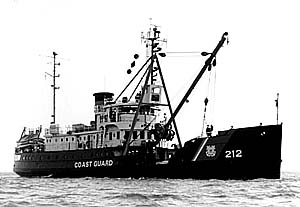USCGC Fir (WLM-212)
 |
|
| History | |
|---|---|
|
|
|
| Namesake: | Fir |
| Operator: | |
| Builder: | Moore Drydock Company, Oakland, California |
| Cost: | US$389,746 |
| Yard number: | Hull number 194 |
| Laid down: | 7 January 1939 |
| Launched: | 18 May 1939 |
| Sponsored by: | Miss Harriet Birta Mason |
| Christened: | 18 May 1939 |
| Commissioned: | 1 October 1940 (USCG) |
| Decommissioned: | 1 October 1991 |
| Maiden voyage: | 18 August 1939 to Portland, Oregon |
| Reclassified: | WLM (1965) |
| Homeport: | Seattle, Washington |
| Identification: | WAGL-212 |
| Nickname(s): | Mother Fir, Building 212 |
| Honors and awards: |
Queen of the Fleet 30 May 1988 |
| Status: | |
| Notes: | Call sign NRYR |
| General characteristics | |
| Class and type: | Hollyhock class, type A |
| Type: | Coast Guard, Auxiliary, General, Lighthouse tender WAGL; Coastal Buoy tender, WLM |
| Displacement: | 885 tons. |
| Length: | 174 ft 8 1⁄2 in (53.251 m) |
| Draft: | 11 ft 3 in (3.43 m) |
| Ice class: | Reinforced bow and stern. Ice-belt at water-line, notched forefoot. |
| Installed power: |
|
| Propulsion: |
|
| Speed: | 12 knots (22 km/h; 14 mph) |
| Range: | 2,000 mi (3,200 km) |
| Complement: | 4 officers, 1 warrant officer, 69 enlisted (1945) |
| Crew: | 74 (1945). |
| Sensors and processing systems: |
Radar: SO-1 (1945); CS (1966). Sonar: WEA-2 (1945); UNQ-1 (1966) |
| Armament: |
|
| Notes: | Deck gear: boom, electrically powered, 20 ton hoisting capacity (1940); replaced in 1982 with hydraulic boom and A-frame system with a 15 ton hoisting capacity |
|
USCGC Fir
|
|
| Location | As of June 2010: Pier 38, San Francisco, California. |
| Coordinates | 37°46′56″N 122°23′11″W / 37.78222°N 122.38639°WCoordinates: 37°46′56″N 122°23′11″W / 37.78222°N 122.38639°W |
| Built | 1939 |
| NRHP reference # | 92001880 |
| Significant dates | |
| Added to NRHP | 27 April 1992 |
| Designated NHL | 27 April 1992 |
The United States Coast Guard Cutter Fir (WAGL/WLM 212) was the last lighthouse tender built specifically for the United States Lighthouse Service to resupply lighthouses and lightships, and to service buoys. Fir was built by the Moore Drydock Company in Oakland, California in 1939. On 22 March 1939, the U.S. Lighthouse Tender Fir was launched. She was steam driven with twin screws, 175 feet (53 m) in length, had a beam of 32 feet (9.8 m), drew 11 feet 3 inches (3.43 m) of water, and displaced 885 tons. Fir was fitted with a reinforced bow and stern, and an ice-belt at her water-line for icebreaking. She was built with classic lines and her spaces were lavishly appointed with mahogany, teak, and brass. The crew did intricate ropework throughout the ship. The cost to build Fir was approximately US$390,000. Fir's homeport was Seattle, Washington for all but one of her fifty one years of service when she was temporarily assigned to Long Beach, California when USCGC Walnut was decommissioned on 1 July 1982.
On 1 July 1939 the United States Lighthouse Service became a part of the United States Coast Guard. On 1 October 1940 Fir was commissioned as the United States Coast Guard Cutter Fir (WAGL-212). With the onset of World War II Fir was assigned to the U.S. Department of the Navy and painted battleship grey. The following armament was installed for war service: M2 Browning machine guns, a 3-inch gun, and depth charges. Her wartime duties included picket duty, towing gunnery targets, and patrolling the Washington and Oregon coasts. In 1965, Fir was reclassified as a USCG coastal buoy tender (WLM).
On 27 May 1988, after the decommissioning of USCGC Ingham, Fir gained the distinction as the U.S. Coast Guard's oldest commissioned cutter. In accordance with a Coast Guard custom, she displayed gold hull numbers on her bow and was designated as "Queen of the Fleet" on 30 May 1988. On 1 October 1990, the 200th anniversary year of the U.S. Coast Guard, Fir was honored again with the celebration on her 50th birthday. One year later, on 1 October 1991 Fir was decommissioned, and; on 27 April 1992 was designated a National Historic Landmark by the United States Secretary of the Interior.
...
Wikipedia
